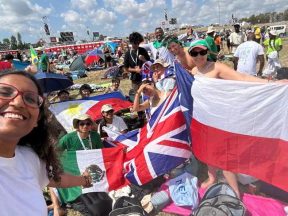Papua New Guinea. Peter To Rot. “I am here because of my faith”.
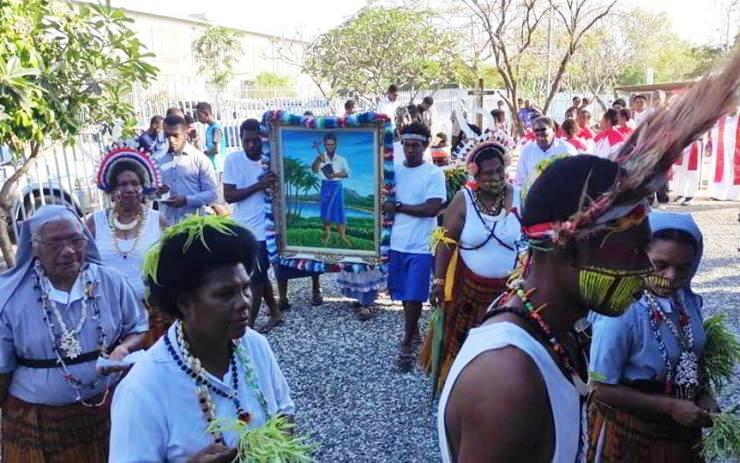
On October 19, 2025, World Mission Day, Pope Leo XIV will canonise Peter To Rot. The first saint of Papua New Guinea.
The Tolai people live on the Gazelle Peninsula, in the northeast of the island of New Britain, Papua New Guinea. They are one of dozens of ethnic groups that populate the archipelago surrounding the main island. The first missionaries, both Catholic and Protestant, began to evangelise the islands in the late 19th century, leaving from Sydney, Australia. In September 1882, three French missionaries of the Sacred Heart landed at Vunapope, on the Gazelle Peninsula. The missionaries were welcomed by the Tolai and opened a mission station in Rakunai, one of their most important villages. And it is here that we find Peter To Rot’s family. His father was Angelo To Puia, a Rakunai village chief and leader of his clan. His mother was Maria Ia Tumul. Peter was the third of six children: four brothers and two sisters.
Peter was probably born in 1912. His family was Christian. His father was baptised in 1898 and was one of the first Catholics among the Tolai.

The first missionaries, both Catholic and Protestant, began to evangelise the islands in the late 19th century. 123rf
To Puia was a highly respected chief, a good father and an excellent Christian. He was the one who invited the missionaries to live in the village, to build a church and a school. He was the chief of the area for about 40 years and died in 1938.
To Rot was baptised the same year of his birth. He received his Christian education mainly from his father. At the age of seven, he was admitted to the Rakunai primary school. There, he learned the Bible very well, managing to memorise many passages. Given his commitment, he received his first Communion when he was just eleven years old. When the missionary asked for volunteers to serve mass every day, he was one of the first to volunteer.
Once he was past adolescence, he should have left school, but he wanted to continue. The parish priest, who followed him closely, was aware of his love for the Eucharist, so in 1930, at the age of 18, Peter entered the Saint Paul Catechist Training Centre in Taliligap, a centre founded in 1925 for the entire vicariate of Melanesia. The school welcomed young people from over thirty language groups in the vicariate to prepare them to become catechists: it trained them spiritually, taught them methods for communicating the Gospel and everything needed to animate a community even in the absence of a priest: how to organize and manage a village primary school, and learn the local language, if necessary. The catechetical centre provided methods and content for both religious and basic school teaching, as well as record-keeping and organising extracurricular activities.
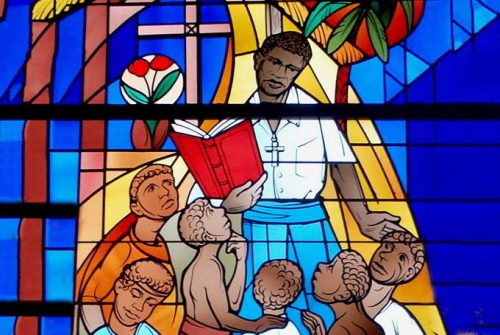
Peter To Rot in his village at Rakunai. Courtesy: Fr. Tomas Ravaioli IVE
Once he arrived at the centre, To Rot immediately felt at home. He threw himself into his studies and became one of the best students. The course lasted three years, but already at the beginning of 1933, Peter was sent to his village, Ranukai, because the catechist had left, and there was no one to help the priest. He was then 21 years old. His only desire was to serve with humility and dedication, creating a deep collaboration with the priest, working with him and asking him for insights into aspects of the faith that were not yet clear to him. He had only one thing in mind: to be a good catechist and to serve Jesus with all his heart.
On November 11, 1936, he married Paula Ia Varpit, who was only 16 years old, in church. The marriage of Peter and Paula was an example for all. Their union would be blessed with two children: Andea To Puia
and Rufina la Mama.
Japanese occupation
On January 4, 1942, the Japanese occupied New Britain, chasing out the Australians. On January 25, they arrived in Rakunai. At first, the Japanese allowed Father Laufer, the parish priest, to stay, but then all the missionaries were interned. Thus, the care of the Christians fell entirely to the catechists. To Rot, although aware of the gravity of the situation and the risks he was running, took on the responsibility of being close to the Christians and supporting their faith. He continued to lead Sunday prayers, baptise children, train young couples and bless their marriages, help the poorest, visit the sick and bury the dead.
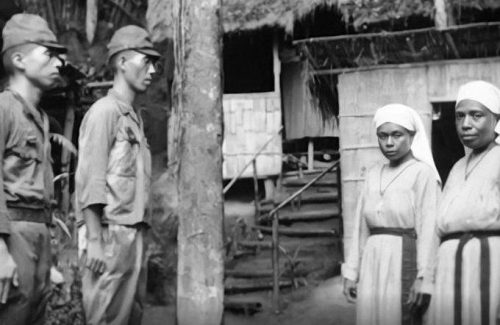
The Japanese soldiers spoke to the nuns. However, all the missionaries were soon interned. Archive
Things changed for the worse in March 1943. The Japanese felt the weight of the Allied attacks, and New Britain passed from civil to military administration. One of the consequences was that the occupiers controlled the catechists more and reduced their activities. To Rot was summoned by the police, who forbade him from meeting with large groups of Christians. At the same time, they completely destroyed the church, with the excuse that it was a large building and therefore too visible to the Allied bombers. To Rot obtained permission to build a smaller and more camouflaged chapel. The entire community helped him build a little church of palm branches.
In March 1944, the situation worsened. The Japanese were losing the war and controlled only the Gazelle peninsula, which was frequently bombed by the Allies and cut off from supplies by sea.
The police summoned the Catholic catechists and the Methodist pastors and informed them that all religious activities were prohibited. To Rot protested, but the Japanese officer, Meshida, brutally silenced him.
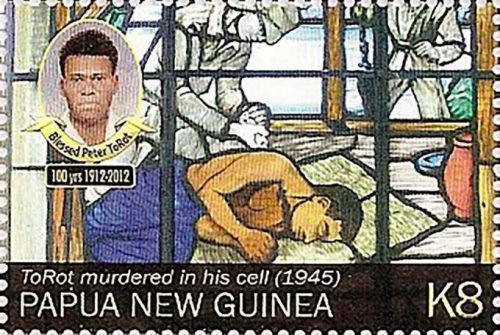
Stamp depicting the moment of the execution of To Rot.
Back home, he refused to give in. “They want to take away our prayer, but I will continue with my work”, he said. By now he was alone. All the missionaries were in a concentration camp; his fellow catechists were too afraid, and the orders of the Japanese forbade any pastoral activity. Not only that: the occupiers requisitioned every religious symbol (books, crucifixes, images) and confiscated and burned all the parish registers.
To Rot went out at night to meet the Christians gathered in small groups in secret places, prayed with them, instructed them, baptised children and blessed marriages. He recommended prudence to his Christians and invited them to persevere in prayer without showing themselves in public. He was well aware that he was risking prison and his own life.
In June 1944, the situation worsened even more. The Japanese were in dire straits and sought the support of the local population. For this reason, they offered rewards to local leaders and, to curry favour with them, decided to restore an ancient cultural tradition of the Tolai: polygamy, forbidden by Christianity and outlawed by previous governments. Not only did they legalise it, but they also punished anyone who objected to this decision. The proposal was welcomed by several leaders and even by one of To Rot’s brothers, Tatamai. To Rot did not accept the decision. He continued his service and his testimony, which had a great influence on his people. This put him in direct conflict with the Japanese, especially with the police chief, Meshida, and To Metapa, a local policeman in their service. The latter wanted to take a Christian woman who was already married as a second wife. To Rot intervened by helping the woman in front of the village chief, and she managed to return to her husband. The policeman was furious with To Rot and looked for every opportunity to eliminate him.
Arrest
One evening in May 1945, To Metapa was on patrol and stopped a young couple. When questioned about what they were doing out and about at that hour, the two, frightened, said they were returning from To Rot’s family home, where he had just celebrated some weddings, including theirs. To Metapa had the excuse he was looking for and had Peter To Rot and his two brothers arrested the next morning. They searched the house where the three brothers lived from top to bottom, and destroyed all of Peter’s religious material: his Bible, crucifix, catechism, song books, baptism and marriage registers. Then, they beat him and his brothers. His brothers were sentenced to a month in prison, and he to two months. His clear opposition to polygamy made the situation worse. He was taken to the Vunaiara prison camp and locked in a small underground room. During the few visits he received, he said to his elderly mother and his wife Paula: “Do not cry. Pray. I am here for a good cause. I am happy, since I am here because of my faith”.
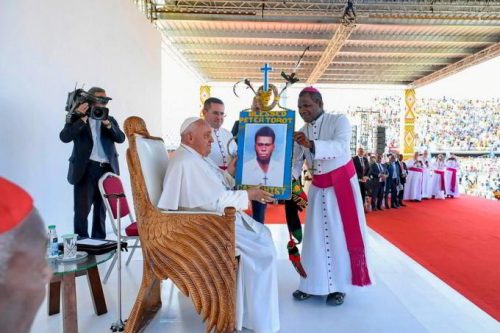
Pope Francis was presented with an image of Blessed Peter To Rot in Port Moresby on September 9, 2024 (Vatican Media)
Peter To Rot was well aware that he would be killed, but he was not afraid. Two days before he died, his pregnant wife came to visit him with their two children. She brought him the crucifix he had asked for and had kept hidden. She asked him to stop being a catechist and retire to a quieter life. “Do not worry. It is my duty to die for God the Father, Son and Holy Spirit and for my people”, was his answer. When she insisted, he said: “Do not stop me from doing my job. It is God’s work”.
To his mother, who came to visit him, he said: “The police told me that they are waiting for a Japanese doctor who is to come and give me medicine. I think it is a lie, because I am not sick. I do not know what this means”. That night, two Japanese doctors came and all the prisoners, accompanied by the local police, were sent out to a nearby farm to play and have fun under the full moon, even though it was raining. All except To Rot and a boy 15 years his junior. There were no witnesses around.
The head guard sent the boy to call To Rot and then chased him away. Hiding on the hillside nearby, he saw a doctor give Peter an injection and then give him something to drink. He then made him lie down and stuffed his nose and ears with cotton. Peter tried to vomit, but the doctor covered his mouth, held him down and hit him on the throat with a stick. After a while, To Rot became still and died. The boy ran to tell the others what he saw. All the prisoners, when they returned to the prison, saw Peter To Rot’s body, but, frightened, they retired in silence.
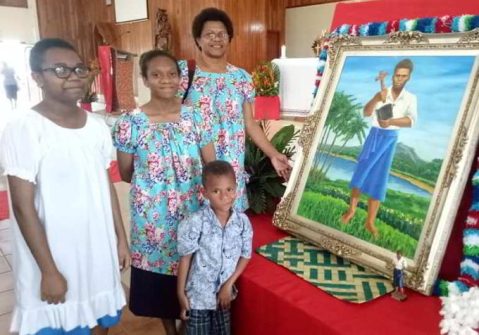
A family around the image of Peter To Rot. Courtesy: Blessed Petro Torot Foundation Inc.
The next day (July 7), after the usual morning roll call, everyone went to work. When some Japanese collaborators arrived, they saw To Rot’s body and raised the alarm. The guards pretended to be surprised. The police chief, Mishida, covered the body with a cloth and told everyone: “The ‘mission boy’ was very ill and died. Tell Chief Tata of Rakunai and his relatives to come and take him away.”
Chief Tata came quickly and found To Rot’s body still warm. His nose and mouth were stuffed with cotton wool, a smelly foam was coming from the corners of his mouth, his neck was swollen, evidence of a blow, there were two bloody cuts on the back of his head and the red mark of a puncture in the vein of his left arm: it was clear to everyone that To Rot had been killed.
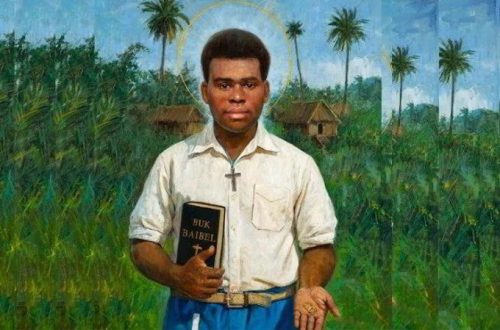
Peter To Rot. “I am happy, since I am here because of my faith”. Courtesy Fr. Tomas Ravaioli IVE
They then took To Rot’s body home to his family. The coffin was prepared, and people flocked to see him. The funeral was celebrated without solemnity and in silence for fear that the police would make more arrests. They buried him in his mother’s family cemetery, according to their traditions. From the day of his funeral, To Rot was seen as a martyr of the Catholic faith. His faith and testimony spread throughout the islands. People still consider him a martyr and a saint, an example to follow.
Visiting Papua New Guinea, January 17, 1995, Pope John Paul II declared Peter To Rot a martyr and blessed. Three weeks before his death, Pope Francis continued the process, authorising his canonisation on March 31, 2025. Pope Leo XIV will enrol To Rot in the register of saints on October 19, in the context of World Mission Day. He will be the first saint of Papua New Guinea. (Open Photo: Procession with the image of To Rot. Courtesy: Blessed Petro Torot Foundation Inc.)
Gigi Anataloni/MC



